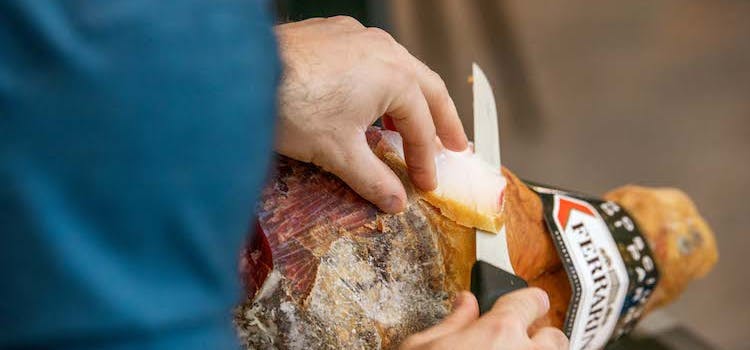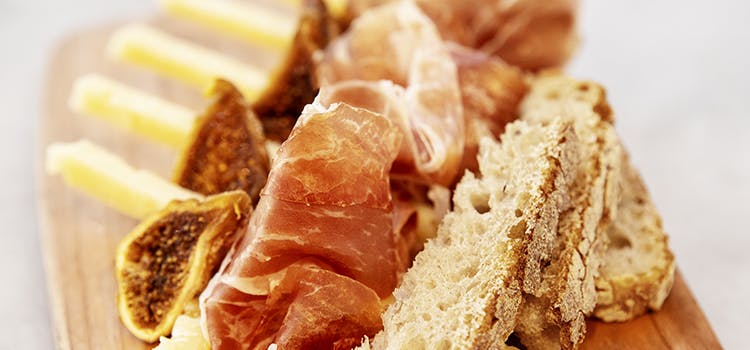In Italy, your grocery shopping isn’t complete without a stop at the salumificio. These small shops boast a distinctly salty, savory scent as you walk in thanks to the salumi hanging from the ceiling. What better way to bring the authentic salumificio experience home than with a perfectly aged whole leg to slice by hand all summer long?
This holiday, we’re featuring whole legs of Ferrarini Prosciutto di Parma online, so you can bring a taste of this artisan tradition home. Made with just pork, salt, air, and time, Prosciutto di Parma DOP can only be produced from the hind legs of specially selected heritage breed pigs raised in the 11 approved regions of Italy. Get the full guide for how to care for your leg, then build your perfect aperitivo board again and again.

How to open the leg
First things first: make sure that you refrigerate your leg immediately upon receiving it. When you’re ready to open your leg, cut open the vacuum packaging and unwrap it. If you see a little mold, don’t worry – this is normal, as Prosciutto di Parma is a completely natural product, and you can wipe or cut it off.
Next, dry out the leg. Simply unwrap the vacuum sealing, place it on a towel or cutting board and let the leg breath, cleaning off any excess sugna (rendered pork fat used to preserve the leg) or sweat with a clean towel.
How to slice a whole leg
Ready to prep your aperitivo board? You don’t need a fancy meat slicer to get the job done. You’re probably used to the paper-thin, even slices you find at the salumi and formaggi counter at your local Eataly. We don’t expect you to have the same industrial tools at home, but luckily, slicing by hand is an art that lets you appreciate the centuries of tradition behind each leg, giving you a textured bite that adds even more sensations to the palate. So, let’s get slicing!
USE THE RIGHT KNIFE
First, find yourself a good slicing knife. It should have a sharp, long blade that is wide and thick, and flexible enough to adapt itself to the form of the prosciutto leg. A meat carving knife works great, just don’t use a serrated knife!
CLEAN OFF THE SKIN
Before every cutting or slicing, you will have to first remove a section of the skin near the point of the cut. Try to cut the skin without removing a lot of fat. The fat is where the flavor is, and it also aids in preserving the leg of prosciutto. Remove the skin evenly across the leg in small increments on the basis of what you intend to cut or slice each time. Nota bene: do not ever remove all of the skin at once unless you are planning to slice the leg in its entirety. Remember, the skin also protects the leg, so removing too much may expose too much fat, which will eventually oxidize.
SLICE AGAINST THE GRAIN
If you don’t have a fancy holder, grab the leg by the thinner end and prop it up against a non-slippery surface, like a wood cutting board. Begin the cut near the top of the prosciutto leg and slice against the grain. The cuts should always move in the same direction, starting from the skinny end and moving away toward the wider end of the leg (your goal is to leave a flat surface along the line that you cut).

How to store your leg
Once you have sliced to your liking, simply wrap your Prosciutto di Parma DOP well in plastic wrap and place back in the fridge. Make sure to keep it away from strong aromas like onions, which can affect the flavor. Wrapped and stored this way, the leg can keep for two months or even longer. If you see a little mold develop, don’t worry – just trim it away before you slice the next time.
Remember, it is also important to keep the leg away from the oven and hot surfaces. If the leg reaches a warmer temperature and then cools back down, it can become rancid.
How to pair
When it comes to pairing Prosciutto di Parma, the options are endless. Savor the microclimate of the Parma region by pairing your cured meat with Parmigiano Reggiano DOP and a glass offrizzante(sparkling) Lambrusco from the same region of origin, Emilia-Romagna. Or, use your slices to make the classic Saltimbocca for a savory main dish (get the recipe here) or to stuff a panino for a picnic treat. Get our guide to building the perfect antipasto platter for more ideas.

What about leftovers?
Italians are known for their resourcefulness in the kitchen, and are not quick to throw anything away. That goes for prosciutto, too! If you have any leftovers from the end of the leg, save it for your next broth and add it for extra depth of flavor. Your soups and risotti will thank you.
Ready to get slicing? Pick up a whole leg of Prosciutto di Parma DOP online or in-store at your local Eataly.